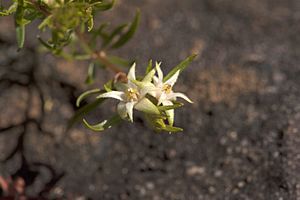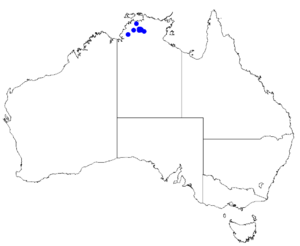Boronia decumbens facts for kids
Quick facts for kids Boronia decumbens |
|
|---|---|
 |
|
| Boronia decumbens in Kakadu National Park | |
| Scientific classification | |
 |
|
| Occurrence data from Australasian Virtual Herbarium |
The Boronia decumbens is a special plant that belongs to the citrus family, called Rutaceae. It is found only in the northern parts of the Northern Territory in Australia. This means it is endemic to that area, growing naturally nowhere else in the world! It's a small, spreading bush with leaves that look a bit like feathers, and it has pretty white to pink flowers.
Contents
What is Boronia Decumbens Like?
A Spreading Shrub
The Boronia decumbens is a low, spreading bush. It usually grows to about 10 centimetres (4 inches) tall and can spread out to about 40 centimetres (16 inches) wide. Its branches, leaves, and some parts of its flowers are a bit hairy.
Its Leaves and Flowers
The leaves of this plant are about 6 to 20 millimetres (0.2 to 0.8 inches) long and 5 to 25 millimetres (0.2 to 1 inch) wide. Each leaf has five or seven small, narrow leaflets. The leaflet at the end is usually 6 to 12 millimetres (0.2 to 0.5 inches) long, while the side ones are 4 to 11 millimetres (0.2 to 0.4 inches) long.
The flowers grow directly from where the leaves meet the stem. They are white or pink. Each flower has four sepals (the leaf-like parts that protect the bud) and four petals (the colourful parts). The sepals are bigger than the petals. The sepals are shaped like triangles and are about 4 to 6 millimetres (0.16 to 0.24 inches) long. The petals are about 3 to 5 millimetres (0.12 to 0.20 inches) long. You can see these lovely flowers from November all the way through to August.
How Was it Named?
The Story Behind the Name
The Boronia decumbens was officially described and named in 1997 by a scientist named Marco F. Duretto. He wrote about it in a scientific journal called Nuytsia.
The second part of its name, decumbens, comes from a Latin word. It means "lying down" or "reclining." This name was chosen because the plant usually grows low to the ground and spreads out, almost like it's lying down.
Where Does it Grow?
Its Home in Northern Australia
This special boronia plant grows in the woodlands of Kakadu National Park. You can find it north of the Mary River and near the turnoff to Waterfall Creek. It likes to grow in these specific areas of the Northern Territory.

